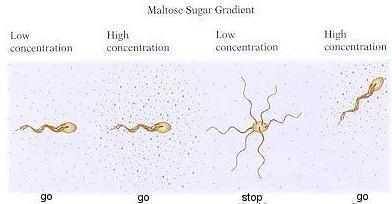Working Brain
Brain anatomy
Search CIDPUSA WEBSITE
😏
AUTOIMMUNE EPIDEMICFriday, 24 June 2005
- Brain
Neurons and Nerves
Neurotransmitter
The Brain
Spinal Cord
Peripheral Nervous System
Autonomic Nervous System
Senses: Sight,Senses, Smell,Taste, Sences,Senses
Memory
Higher Functions
Altered StatesThe Brain
Brains exist because the distribution of resources necessary for survival and the hazards that threaten survival vary in space and time. There would be little need for a nervous system in an immobile organism or an organism that lived in regular and predictable environment. Brains are informed by the senses about the presence of resources and hazards; they evaluate and store this input and generate adaptive responses executed by the muscles.
 Some of the most basic features of brains can be found in bacteria because even the simplest motile organisms must solve the problem of locating resources and avoiding toxins. They sense their environment through a large number of receptors, which are protein molecules embedded in the cell wall. The action taken in response to the inputs usually depends on the gradient of the chemicals (see Figure 03a). Thus memory is required to compare the inputs from different locations. The strength of the signal is modulated by immediate past experience. This in turn regulates the strength of the signal sent by chemical messengers from
Some of the most basic features of brains can be found in bacteria because even the simplest motile organisms must solve the problem of locating resources and avoiding toxins. They sense their environment through a large number of receptors, which are protein molecules embedded in the cell wall. The action taken in response to the inputs usually depends on the gradient of the chemicals (see Figure 03a). Thus memory is required to compare the inputs from different locations. The strength of the signal is modulated by immediate past experience. This in turn regulates the strength of the signal sent by chemical messengers from Figure 03a E. coli's Response to Chemical Gradient[view large image]
the receptor to the flagellar motors. Thus even at the unicellular level, the bacteria have already possessed the ability to integrate numerous analog inputs and generate a binary (digital) output of stop or go. In multicellur organism, cells specialized for receptor function are located on the surface. Other cells specialized for the transmission and analysis of information are located in the protected interior and are linked to effector cells, usually muscles, which produce adaptive responses. As do unicellular organisms, neurons integrate the diverse array of incoming information from the receptors, which in neurons may result in the firing of an action potential (when the summation is above a threshold level) rather than swimming toward a nutrient source as in the unicellular organisms. Once the threshold for generating an action potential is reached, the signal is always the same, both in amplitude and shape (a nerve consists of many neurons, it does not obey the all-or-none law).
Action potentials and voltage-gated sodium channels are present in jellyfish, which are the simplest organisms to possess nervous systems. The development of this basic neuronal mechanism set the stage for the proliferation of animal life that occurred during the Cambrian period. Among these Cambrian animals were the early chordates, which possessed very simple brains. Some of these early fish developed a unique way to insulate their axons by wrapping them with a fatty material called myelin, which greatly facilitated axonal transmission and evolution of larger brains. Some of their descendants, which also were small predators, crawled up on the muddy shores and eventually took up permanent residence on dry land. Challenged by the severe temperature changes in the terrestrial environment, some experimented with becoming warm-blooded, and the most successful became the ancestors of birds and mammals. Changes in the brain and parental care were a crucial part of the set of mechanisms that enabled these animals to maintain a constant body temperature.
Animals with large brains are rare -- there are tremendous costs associated with large brains (the active human brain consumes about 20 watts). The brain must compete with other organs in the body for the limited amount of energy available, which is a powerful constraint on the evolution of large brains. Large brains also require a long time to mature, which greatly reduces the rate at which their possessors can reproduce. Because large-brained infants are slow to develop and are dependent on their parents for such a long time, the parents must invest a great deal of effort in raising their infants. Young reptiles function as miniature versions of adults, but baby mammals and birds are dependent because of their poor capacity to thermo-regulate, the consequence of their need to devote most their energy to growth. Most mammals solve the problem with maternal care (Figure 03b), shelter, warmth, and milk. In most birds, both parents cooperate to provide food and shelter to their young. The expanded forebrain and parental care provide mechanisms for the extra-genetic transmission of information from one generation to the next. This transmission results from the close contact with parents during infancy, which provides the young with opportunity to observe and learn from their behavior; the expanded forebrain provides an enhanced capacity to store these memories. The expanded forebrain and the observation of parents
miniature versions of adults, but baby mammals and birds are dependent because of their poor capacity to thermo-regulate, the consequence of their need to devote most their energy to growth. Most mammals solve the problem with maternal care (Figure 03b), shelter, warmth, and milk. In most birds, both parents cooperate to provide food and shelter to their young. The expanded forebrain and parental care provide mechanisms for the extra-genetic transmission of information from one generation to the next. This transmission results from the close contact with parents during infancy, which provides the young with opportunity to observe and learn from their behavior; the expanded forebrain provides an enhanced capacity to store these memories. The expanded forebrain and the observation of parents Figure 03b Maternal Care
are probably necessary for the establishment of successful care giving behavior itself, as the young mature into adults that will in their turn have to serve dependent young. During the period of infant dependency, baby mammals and birds play,
[view large image]
Continued to next page